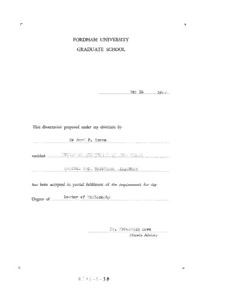Table Of Contentr
FORDHAM UNIVERSITY
GRADUATE SCHOOL
19LP.
This dissertation prepared under my direction by
Bernard F. Cro^e
entitled .............- • U.-. - ./rC.-i.... :e.__ PiLheDirUPiF.:
DeiilM'tu DDG.u THiOPHeMe DLDaHXDDS
has been accepted in partial fulfilment of the requirements for the
Degree of 1)0 c tOP
Dr. Friedrich Nord
(Faculty Adviser)
r
Studies on Azlactones and Rhodanines
Derived from Thiophene Aldehydes
By
Bernard F. Crowe
B.S., Fordham College, 1943
M.S., Fordham University, 1948
DISSERTATION
SUBMITTED IN PARTIAL FULFILLMENT OF THE REQUIREMENTS FOR THE
DEGREE OF DOCTOR OF PHILOSOPHY IN THE DEPARTMENT OF CHEMISTRY
AT FORDHAM UNIVERSITY
NEW YORK
1950
L -J
ProQuest Number: 10992988
All rights reserved
INFORMATION TO ALL USERS
The quality of this reproduction is dependent upon the quality of the copy submitted.
In the unlikely event that the author did not send a complete manuscript
and there are missing pages, these will be noted. Also, if material had to be removed,
a note will indicate the deletion.
uest
ProQuest 10992988
Published by ProQuest LLC(2018). Copyright of the Dissertation is held by the Author.
All rights reserved.
This work is protected against unauthorized copying under Title 17, United States Code
Microform Edition © ProQuest LLC.
ProQuest LLC.
789 East Eisenhower Parkway
P.O. Box 1346
Ann Arbor, Ml 48106- 1346
i
r H
TABLE OP CONTENTS
page
I. List of Tables andF igures........ ii
Acknowledgements.................... iii
General Introduction............. 1
II. Instrumental Techniques.......... 3
III. Materials................ 7
IV. Azlactones
A. Introduction. 8
B. Experimental.............. 15
C. Discussion.................... 30
V. Rhodanine Synthesis
A. Introduction......... 35
B. Experimental................... 39
G. Discussion............ 61
VI. ft -2-Thienylalanines
A. Introduction.................. 65
B. Experimental........ 68
C. Discussion.................... 81
VII. Summary........... ...............85
Bibliography........................ 88
L -J
ii
!. LIST OF TABLES AND FIGURES
TABLE PAGE
1. Azlactones Prepared from Thiophene
Aldehydes and Hippuric Acid. 54
II. Rhodanine Condensation Products of
Thiophene Aldehydes. 47
III. Rhodanine Cleavage Products. 51
IV. 3(2-Thienyl)-2-oximinopropionic acids
derived through the Rhodanine Syntheses. 56
V. -2-Thienylalanines prepared by the
Rhodanine Synthesis. 75
FIGURE PAGE
1 . Ultra-violet absorption spectrum of
potassium chromate. __5__
.
2 Ultra-violet absorption spectrum of
azobenzene. __6_
3. Ultra-violet absorption spectra of
monosubstituted azlactones. 22
4. Ultra-violet absorption spectra of
di- and trisubstituted azlactones. 23
5. Ultra-violet absorption spectrum of
2-methyl-4(2-thenal)5-oxazolone. 24
6. Ultra-violet absorption spectra of
Rhodanine s. 45
ill
A cknowledgement s
The author wishes to express his gratitude
to his parents and sister for their guidance and
assistance•
This investigation was aided, in part, by a
grant from the Office of Naval Research.
This study was carried out under the
direction of Dr. P. F. Nord.
L Jl
Studies on Azlactones and Rhodanines
Derived from Thiophene Aldehydes.
1
r i
Introduction
Aromatic aldehydes have been used as starting materials
in a variety of syntheses. As a particular example, conden
sations between aldehydes and compounds containing an active
methylene group have proved to be of considerable interest
and importance. For the preparation of amino acids, such
substances as hydantoin, thiohydantoin, diketopiperazine,
hippuric acid, acetylglycine and rhodanine have been employed.
The condensation products formed by the latter three reagents
have been shown to serve as versatile intermediates for the
synthesis of many other products as well. The unsaturated
azlactones resulting from aldehyde condensations with
hippuric acid and acetylglycine have been utilized to
obtain c^-keto acids, arylacetic acids, styrylamides and
isoquinoline derivatives. Rhodanine intermediates have been
converted to arylthionopropionic acids, arylacetonitriles,
arylacetic acids and arylethylamines.
While differences in reactivity exist between benzene
and its analog, thiophene, due to the influence of the hetero
sulfur atom, their aldehydes and other derivatives in many
instances show some similarity in behavior. The study of the
reactions of benzaldehyde has been covered extensively in the
literature but that of 2- and 3-thenaldehyde has been neg
lected until comparatively recent times. As late as 1941
Steinkopf wrote "Thiophenaldehyde sind nicht viele bekannt.1’
This situation may be attributed in part to the lack of
suitable methods for the preparation of thiophene aldehydes.
L J
2
r i
The application of the Sommelet reaction (36) and N-methyl-
formanilide synthesis (71) to the thiophene series has
ameliorated this condition. The discovery that diverse
thiophene products possess important physiological prop
erties has captured the attention of numerous scientific
workers and other interests which have oriented the efforts
of their researches to this field. Topics which have been
investigated include amines displaying pressor action (15)
and antihistaminic properties (17, 27, 28, 29, 74, 101),
narcotics (18, 19, 26, 30, 31, 47, 57, 98, 100) and amino
acid antagonists (10, 12, 25, 32, 33, 34, 35, 37, 48, 54,
68).
Inasmuch as azlactones and rhodanines have been demon
strated to be flexible tools for organic syntheses, their
study in the thiophene series was undertaken.
L ■J

